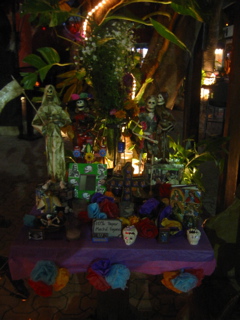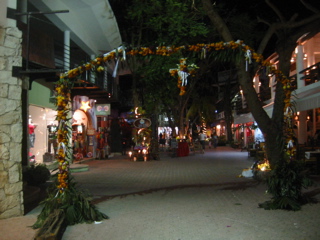Day of the Dead/Dia de los Muertos:
Day of the Dead is one of my favorite holidays in Mexico and I really wish we celebrated it in the USA. It's a holiday to honor the deceased. We probably won't see much of the holiday because it doesn't occur until November 1 and 2, but I wanted to mention it incase you do see altars or sugar skulls or pan de muerto (yummy, sweet bread-if you see it, try it!), etc.
Many observants believe that during the Day of the Dead, it is easier for the souls of the departed to visit the living. People will go to cemeteries to communicate with the souls of the departed, and will build private altars, containing the favorite foods and beverages, and photos and memorabilia, of the departed. The intent is to encourage visits by the souls, so that the souls will hear the prayers and the comments of the living directed to them. Celebrations can take a humorous tone, as celebrants remember funny events and anecdotes about the departed. The altars can be so beautiful!
I copied the info below from Wikipedia:
Plans for the festival are made throughout the year, including gathering the goods to be offered to the dead. During the period of November 1 and November 2, families usually clean and decorate graves; most visit the cemeteries where their loved ones are buried and decorate their graves with ofrendas, or offerings, which often include orange marigolds. These flowers are thought to attract souls of the dead to the offerings.
Toys are brought for dead children, and bottles of tequila, mezcal, pulque or atole for adults. Families will also offer trinkets or the deceased's favorite candies on the grave. Offers are also put in homes, usually with foods such as candied pumpkin, pan de muerto ("bread of the dead") or sugar skulls and beverages such as atole. The ofrendas are left out in the homes as a welcoming gesture for the deceased. Some people believe the spirits of the dead eat the "spiritual essence" of the food, so even though the celebrators eat the food after the festivities, they believe it lacks nutritional value. Pillows and blankets are left out so that the deceased can rest after their long journey. In some parts of Mexico, people spend all night beside the graves of their relatives.
Some families build altars or small shrines in their homes. These altars usually have the Christian cross, statues or pictures of the Blessed Virgin Mary, pictures of deceased relatives and other persons, and scores of candles. Traditionally, families spend some time around the altar praying and telling anecdotes about the deceased. In some locations, celebrants wear shells on their clothing so when they dance the dead will wake up because of the noise. Some will dress up as the deceased.
Public schools at all levels build altars with offerings, usually omitting the religious symbols. Government offices usually have at least a small altar, as this holiday is seen as important to the Mexican heritage.
A common symbol of the holiday is the skull (colloquially called calavera), which celebrants represent in masks, called calacas (colloquial term for "skeleton"), and foods such as sugar skulls, which are inscribed with the name of the recipient on the forehead. Sugar skulls are gifts that can be given to both the living and the dead. Other holiday foods include pan de muerto, a sweet egg bread made in various shapes, from plain rounds to skulls and rabbits often decorated with white frosting to look like twisted bones.
Here are some pictures that I took around town last year:
 (Tony's altar for his parents)
(Tony's altar for his parents)








